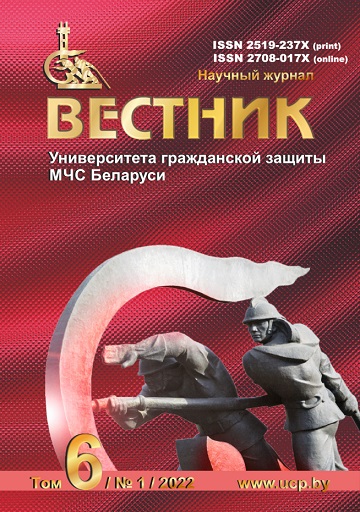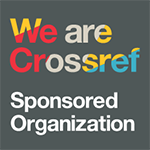Технологии виртуальной и дополненной реальности в образовательном процессе
DOI:
https://doi.org/10.33408/2519-237X.2022.6-1.119Ключевые слова:
виртуальная реальность, дополненная реальность, тренажер, имитация физических воздействий, аварийно-спасательные работы, спасатель, пожарныйАннотация
Цель. Выполнить сбор и анализ научно-технической информации в области использования технологий виртуальной (VR) и дополненной (AR) реальности в образовательном процессе, в частности при подготовке спасателей-пожарных.
Методы. Общая методология работы предусматривала использование теоретических методов исследования (анализ, синтез, сравнение).
Результаты. Проведен сбор и анализ научно-технической информации в области использования виртуальных технологий в образовательном процессе. Рассмотрены общие сведения о VR/AR-технологиях, в частности история их создания, основные области применения, а также технические элементы и устройства, используемые для реализации данных технологий в различных сферах деятельности человека. Рассмотрены направления и способы использования виртуальной и дополненной реальности в образовательном процессе, приведены примеры применяемых за рубежом учебных программно-аппаратных комплексов, тренажеров и платформ для различных направлений образования, а также проанализированы исследования эффективности применения данных технологий в сфере образования в целом. Рассмотрены и проанализированы виртуальные технологии, применяемые для обучения спасателей-пожарных как на территории Беларуси, так и за рубежом.
Область применения исследований. Результаты обзора и анализа сведений о применении технологий виртуальной и дополненной реальности в образовательном процессе могут быть в дальнейшем использованы при разработке VR/AR-тренажеров для подготовки спасателей-пожарных.
Библиографические ссылки
Milgram P., Kishino F. A taxonomy of mixed reality visual displays. IEICE TRANSACTIONS on Information and Systems, 1994. Vol. E77-D, No. 12. Pp. 1321–1329.
Ivanova A.V. VR & AR technologies: opportunities and application obstacles. Strategic decisions and risk management, 2018. No. 3. Pp. 88–107. DOI: https://www.doi.org/10.17747/2078-8886-2018-3-88-107.
LaValle S.M. Virtual reality. University of Illinois. Cambridge: Cambridge University Press, 2016. 418 p.
Maples-Keller J.L., Bunnell B.E., Kim S.-J., Rothbaum B.O. The use of virtual reality technology in the treatment of anxiety and other psychiatric disorders. Harvard Review of Psychiatry, 2017. Vol. 25, Iss. 3. Pp. 103–113. DOI: https://www.doi.org/10.1097/HRP.0000000000000138.
Falconer C.J. Rovira A., King J.A., Gilbert P., Antley A., Fearon P., Ralph N., Slater M., Brewin C.R. Embodying self-compassion within virtual reality and its effects on patients with depression. BJPsych Open, 2016. Vol. 2, Iss. 1. Pp. 74–80. DOI: https://www.doi.org/10.1192/bjpo.bp.115.002147.
Sobolev V.Yu., Kiseleva O.V. Interaktivnye metody obucheniya kak osnova formirovaniya kompetentsiy [Interactive teaching methods as the basis for the formation of competencies]. Vysshee obrazovanie segodnya, 2014. No. 9. Pp. 70–74. (rus)
Andrushko D.Yu. Primenenie tekhnologiy virtual'noy i dopolnennoy real'nosti v obrazovatel'nom protsesse: problemy i perspektivy [Application of virtual and augmented reality technology in educational process: issues and perspectives]. Scientific Review, 2018. No. 6. Pp. 5–10. (rus)
Herron J. Augmented reality in medical education and training. Journal of Electronic Resources in Medical Libraries, 2016. Vol. 13, Iss. 2. Pp. 51–55. DOI: https://www.doi.org/10.1080/15424065.2016.1175987.
Kamphuis C., Barsom E., Schijven M., Christoph N. Augmented reality in medical education? Perspect Med Educ, 2014. Vol. 3. Pp. 300–311. DOI: https://www.doi.org/10.1007/s40037-013-0107-7.
Kelly D., Hoang T.N., Reinoso M., Joukhadar Z., Clements T., Vetere F. Augmented reality learning environment for physiotherapy education. Physical Therapy Reviews, 2018. Vol. 23, Iss. 1. Pp. 21–28. DOI: https://www.doi.org/10.1080/10833196.2018.1447256.
Iqbal J., Sidhu M.S., Wang S. A review on making things see: Augmented reality for futuristic virtual educator. Cogent Education, 2017. Vol. 4, Iss. 1. DOI: https://www.doi.org/10.1080/2331186X.2017.1287392.
Turan Z., Meral E., Sahin I.F. The impact of mobile augmented reality in geography education: achievements, cognitive loads and views of university students. Journal of Geography in Higher Education, 2018. Vol. 42, Iss. 3. Pp. 427–441. DOI: https://www.doi.org/10.1080/03098265.2018.1455174.
Grinshkun A.V. Ob effektivnosti ispol'zovaniya tekhnologiy dopolnennoy real'nosti pri obuchenii shkol'nikov informatike [On the efficiency of use of augmented reality at teaching students computer science]. The academic Journal of Moscow City University. Series: Informatics and Informatization of Edication, 2016. Vol. 35, No. 1. Pp. 98–103. (rus)
Kiryanov A.E., Yilmaz R.M., Maslov D.V., Masyuk N.N., Vorobyev B.A. Tekhnologii dopolnennoy real'nosti v sfere obrazovaniya [Technology of augmented reality in education]. Innovations, 2020. No. 5. Pp. 81–88. (rus). DOI: https://www.doi.org/10.26310/2071-3010.2020.259.5.011.
Wang Y.-H. Exploring the effectiveness of integrating augmented reality-based materials to support writing activities. Computers & Education, 2017. Vol. 113. Pp. 162–176. DOI: https://www.doi.org/10.1016/j.compedu.2017.04.013.
Wang Y.-H. Using augmented reality to support a software editing course for college students. Journal of Computer Assisted Learning, 2017. Vol. 33, Iss. 5. Pp. 532–546. DOI: https://www.doi.org/10.1111/jcal.12199.
Mumtaz K., Iqbal M.M., Khalid Sh., Rafiq T., Owais S.M., Al Achhab M. An E-assessment framework for blended learning with augmented reality to enhance the student learning. Eurasia Journal of Mathematics, Science and Technology Education, 2017. Vol. 8, No. 13. Pp. 4419–4436. DOI: https://www.doi.org/10.12973/eurasia.2017.00938a.
Chang H.-Y., Hsu Y.-S., Wu H.-K. A comparison study of augmented reality versus interactive simulation technology to support student learning of a socio-scientific issue. Interactive Learning Environments, 2016. Vol. 6, No. 24. Pp. 1148–1161. DOI: https://www.doi.org/10.1080/10494820.2014.961486.
Domínguez E.R. Educating urban designers using augmented reality and mobile learning technologies. RIED – Revista Iberoamericana de Educación a Distancia, 2017. Vol. 20, No. 2. Pp. 141–165. DOI: https://www.doi.org/10.5944/ried.20.2.17675.
Montoya M.H., Díaz C.A., Moreno G.A. Evaluating the effect on user perception and performance of static and dynamic contents deployed in augmented reality based learning application. Eurasia Journal of Mathematics, Science & Technology Education, 2017. Vol. 13, Iss. 2. Pp. 301–317. DOI: https://www.doi.org/10.12973/eurasia.2017.00617a.
Bendicho P.F., Mora C.E., Añorbe-Díaz B., Rivero-Rodríguez P. Effect on academic procrastination after introducing augmented reality. Eurasia Journal of Mathematics, Science & Technology Education, 2017. Vol. 13, Iss. 2. Pp. 319–330. DOI: https://www.doi.org/10.12973/eurasia.2017.00618a.
Salinas P., Pulido R. Understanding the conics through augmented reality. Eurasia Journal of Mathematics, Science & Technology Education, 2017. Vol. 13, Iss. 2. Pp. 341–354. DOI: https://www.doi.org/10.12973/eurasia.2017.00620a.
Carrera C.C., Asensio L.A.B. Landscape interpretation with augmented reality and maps to improve spatial orientation skill. Journal of Geography in Higher Education, 2017. Vol. 41, Iss. 1. Pp. 119–133. DOI: https://www.doi.org/10.1080/03098265.2016.1260530.
Martin-Gonzalez A., Chi-Poot A., Uc-Cetina V. Usability evaluation of an augmented reality system for teaching Euclidean vectors. Innovations in Education and Teaching International, 2016. Vol. 53, Iss. 6. Pp. 627–636. DOI: https://www.doi.org/10.1080/14703297.2015.1108856.
Cheng K.-H. Reading an augmented reality book: An exploration of learners’ cognitive load, motivation, and attitudes. Australasian Journal of Educational Technology, 2017. Vol. 33, No. 4. Pp. 53–69. DOI: https://www.doi.org/10.14742/ajet.2820.
Juan M.C., Alexandrescu L., Folguera F., García-García I. A mobile augmented reality system for the learning of dental morphology. Digital Education Review, 2016. No. 30. Pp. 234–247.
Harley J.M. Poitras E.G., Jarrell A., Duffy M.C., Lajoie S.P. Comparing virtual and location-based augmented reality mobile learning: Emotions and learning outcomes. Educational Technology Research and Development, 2016. Vol. 64, No. 3. Pp. 359–388. DOI: https://www.doi.org/10.1007/s11423-015-9420-7.
Bulgakov V.V. Immersivnaya forma podgotovki: aktual'nost' i perspektivy vnedreniya v obrazovatel'nyy protsess vuzov MChS Rossii [Immersive Form of Training: Relevance and Prospects of Implementation in the Educational Process of Higher Education Institutions of the Ministry of Emergency Situations of Russia]. The academic Journal of Moscow City University. Series: Informatics and Informatization of Edication, 2020. Vol. 54, No. 4. Pp. 68–78. (rus). DOI: https://www.doi.org/10.25688/2072-9014.2020.54.4.07.
Malyj I.A., Bulgakov V.V., Sharabanova I.Yu., Orlov O.I. Primenenie tsifrovykh tekhnologiy dlya podgotovki kursantov v oblasti pozharotusheniya [Interdisciplinary Distance Learning Workshop for IT Students]. Educational Resources, 2021. Vol. 25, No. 2. Pp. 51–59. (rus). DOI: https://www.doi.org/10.21686/1818-4243-2021-2-51-59.
Опубликован
Как цитировать
Лицензия
Все права защищены (c) 2022 Полевода И.И., Иваницкий А.Г., Миканович А.С., Пастухов С.М., Грачулин А.В., Рябцев В.Н., Навроцкий О.Д., Лихоманов А.О., Винярский Г.В., Гусаров И.С.

Это произведение доступно по лицензии Creative Commons «Attribution-NonCommercial» («Атрибуция — Некоммерческое использование») 4.0 Всемирная.




















